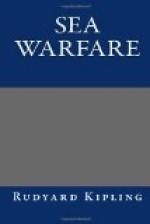DESTROYERS AT JUTLAND
(1916)
“Have you news of my
boy Jack?”
Not this tide.
“When d’you think
that he’ll come back?”
Not with this
wind blowing, and this tide.
“Has any one else had
word of him?”
Not this tide.
For what is sunk will hardly
swim,
Not with this
wind blowing and this tide.
“Oh, dear, what comfort
can I find?”
None this tide,
Nor any tide,
Except he didn’t shame
his kind
Not even with
that wind blowing and that tide.
Then hold your head up
all the more,
This tide,
And every tide,
Because he was the son you
bore,
And gave to that
wind blowing and that tide!
I
STORIES OF THE BATTLE
CRIPPLE AND PARALYTIC
There was much destroyer-work in the Battle of Jutland. The actual battle field may not have been more than twenty thousand square miles, but the incidental patrols, from first to last, must have covered many times that area. Doubtless the next generation will comb out every detail of it. All we need remember is there were many squadrons of battleships and cruisers engaged over the face of the North Sea, and that they were accompanied in their dread comings and goings by multitudes of destroyers, who attacked the enemy both by day and by night from the afternoon of May 31 to the morning of June 1, 1916. We are too close to the gigantic canvas to take in the meaning of the picture; our children stepping backward through the years may get the true perspective and proportions.
To recapitulate what every one knows.
The German fleet came out of its North Sea ports, scouting ships ahead; then destroyers, cruisers, battle-cruisers, and, last, the main battle fleet in the rear. It moved north, parallel with the coast of stolen Schleswig-Holstein and Jutland. Our fleets were already out; the main battle fleet (Admiral Jellicoe) sweeping down from the north, and our battle-cruiser fleet (Admiral Beatty) feeling for the enemy. Our scouts came in contact with the enemy on the afternoon of May 31 about 100 miles off the Jutland coast, steering north-west. They satisfied themselves he was in strength, and reported accordingly to our battle-cruiser fleet, which engaged the enemy’s battle-cruisers at about half-past three o’clock. The enemy steered south-east to rejoin their own fleet, which was coming up from that quarter. We fought him on a parallel course as he ran for more than an hour.




